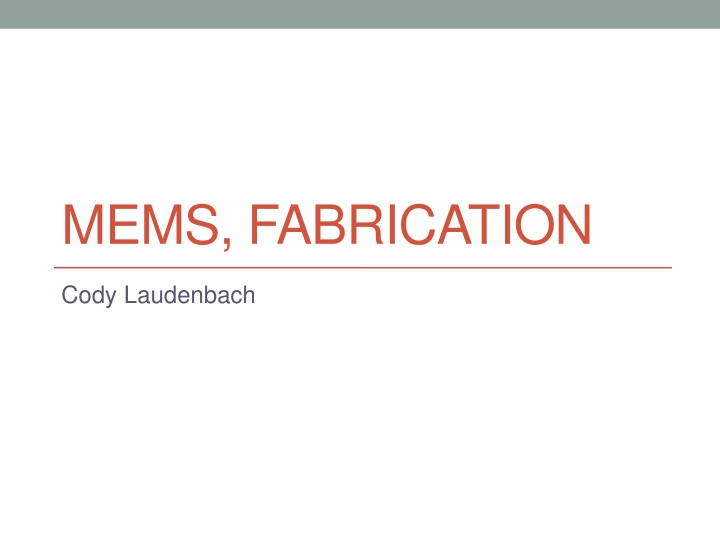
MEMS Fabrication Techniques and Processes
Explore the world of MEMS fabrication with insights on electronics fabrication, bulk and surface micromachining, chemical wet etching, and deep reactive ion etching. Learn about MEMS overview, microelectromechanical systems, and the integration of electrical and mechanical components on silicon substrates. Discover the differences between bulk and surface micromachining techniques and the intricacies of isotropic vs. anisotropic etching. Dive into the realm of electronics fabrication using IC processes and lithography methods.
Download Presentation

Please find below an Image/Link to download the presentation.
The content on the website is provided AS IS for your information and personal use only. It may not be sold, licensed, or shared on other websites without obtaining consent from the author. If you encounter any issues during the download, it is possible that the publisher has removed the file from their server.
You are allowed to download the files provided on this website for personal or commercial use, subject to the condition that they are used lawfully. All files are the property of their respective owners.
The content on the website is provided AS IS for your information and personal use only. It may not be sold, licensed, or shared on other websites without obtaining consent from the author.
E N D
Presentation Transcript
MEMS, FABRICATION Cody Laudenbach
Overview MEMS overview Electronics Fabrication Bulk Micromachining Chemical Wet Etching Isotropic vs anisotropic Deep Reactive Ion Etching Surface Micromachining Molding LIGA
MEMS Overview Microelectromechanical Systems Micrometer scale devices Can range from microns to millimeters Integrates electrical and mechanical parts Can be merged onto SI substrate with IC s Pressure sensors and gyroscopes https://www.memsnet.org/about/what-is.html
Electronics Fabrication Fabricated using IC processes Etching Wet Dry Lithography Photoresist Coating Masking Light exposure
Bulk vs Surface micromachining Bulk Micromachining Bulk micromachining is the selective removal of substrate material Surface Micromachining Surface micromachining is the deposition of thin film in alternating layers, with the sacrificial layer being removed altogether at the end of the process
Bulk Micromachining Chemical wet etching Isotropic Not dependent on crystallographic orientation Theoretically would etch in all directions at equal rates Silicon dioxide or silicon nitride typically used as masking Anisotropic Dependent on crystallographic orientation Etches much faster along <100> crystalline plane than that of the <111> plane Etch rates dependent on chemicals used such as KOH (Potassium Hydroxide)
Bulk Micromachining (Cont.) http://www.tf.uni-kiel.de/matwis/amat/semitech_en/kap_7/backbone/r7_2_2.html
Bulk Micromachining (Cont.) Deep Reactive Ion Etching Bosch process Process Dry plasma etch Alternates between etching and coating an etch resistant polymer layer on the side walls The layer at the bottom of pit is etched faster than that of the side walls
Deep Reactive Ion Etching https://www.mems-exchange.org/MEMS/fabrication.html
Surface Micromachining One of the most common methods of manufacturing MEMS devices Process Films are deposited on substrate, typically alternating between sacrificial and structural layers Patterned through photolithography Sacrificial parts removed, typically through wet chemical etching Results in parts that are able to move relative to the substrate Early processes used Polysilicon as structural layers and some form of silicon oxide for the sacrificial layer. metals, oxides and nitrides of silicon, and polymers have been used for both structural and sacrificial films.
Surface Micromachining (Cont.) https://www.mems-exchange.org/MEMS/fabrication.html
Molding LIGA German acronym for Lithography, Electroplating, and Molding Originally used x-ray source to expose layers out of photosensitive material Current processes use visible light or UV light sources for creating molds
Summary Microelectromechanical systems are a combination of electrical and mechanical components on the micrometer scale Electronic components created using IC fabrication processes, such as etching and lithography Mechanical components created through bulk micromachining, surface micromachining and molding Bulk micromachining is done through wet chemical etching or Deep Reactive Ion Etching Surface micromachining done through alternating structural and sacrificial film layers, then removing sacrificial layers Molding uses photolithography to etch out molds that are then used to create micromechanical parts
References "7.2.1 Important MEMS Processes." 7.2.1 Important MEMS Processes. N.p., n.d. Web. 07 Apr. 2017. <http://www.tf.unikiel.de/matwis/amat/semitech_en/kap_7/backbone/ r7_2_2.html>. "Deep Reactive-ion Etching." Wikipedia. Wikimedia Foundation, 26 Feb. 2017. Web. 07 Apr. 2017. <https://en.wikipedia.org/wiki/Deep_reactive-ion_etching#Bosch_process>. "Fabricating MEMS and Nanotechnology." MNX. N.p., n.d. Web. 07 Apr.2017.<https:// www.mems-exchange.org/MEMS/fabrication.html>. "Introduction to Microelectromechanical Systems (MEMS)." Introduction to Microelectromechanical Systems (MEMS) | Compliant Mechanisms. BYU, n.d. Web. 07 Apr. 2017.<https://compliantmechanisms.byu.edu/ content/introduction- microelectromechanical-systems-mems>. "Semiconductor Device Fabrication." Wikipedia. Wikimedia Foundation, 30 Mar. 2017. Web. 07 Apr. 2017.<https://en.wikipedia.org/wiki/Semiconductor_device_fabrication>. "What Is MEMS Technology?" What Is MEMS Technology? N.p., n.d. Web. 07 Apr. 2017. <https://www.memsnet.org/about/what-is.html>.
Five takeaways MEMS are a combination of electronic and mechanical components on the scale of micrometers Differences: bulk micromachining is the selective removal of substrate material, while surface micromachining is deposition of thin film in alternating layers, with the sacrificial layer being removed altogether at the end of the process DRIE is the process of a dry plasma etching alternating with an etch resistant polymer which allows for a high aspect ratio Anisotropic wet chemical etching is more widely used as it has a higher resolution etching capability Molding is another process of which photolithography is used to create a mold for micromechanical components to then be formed with






















